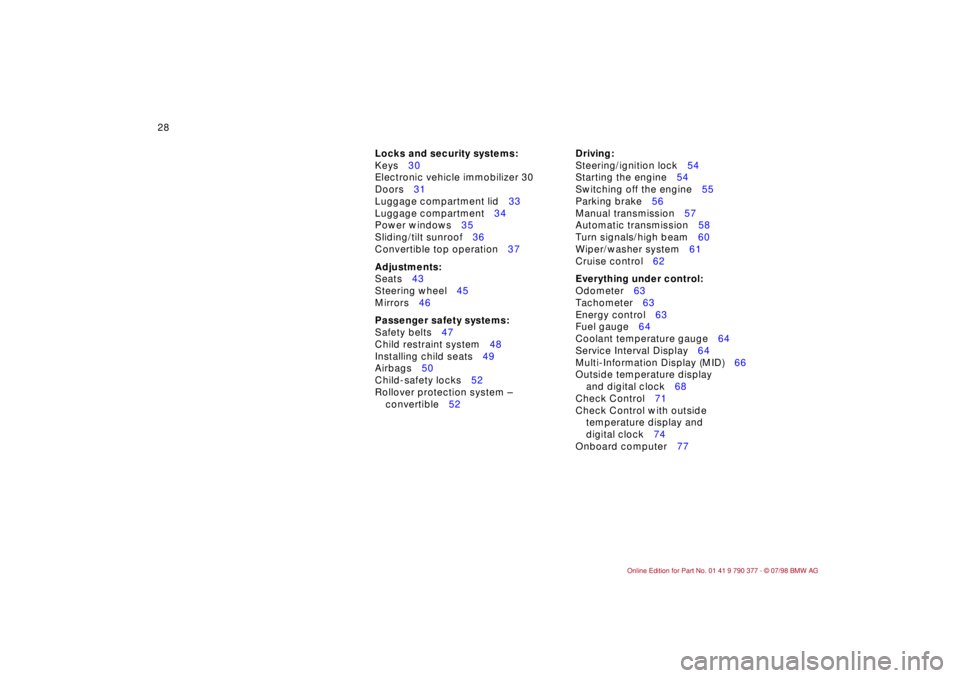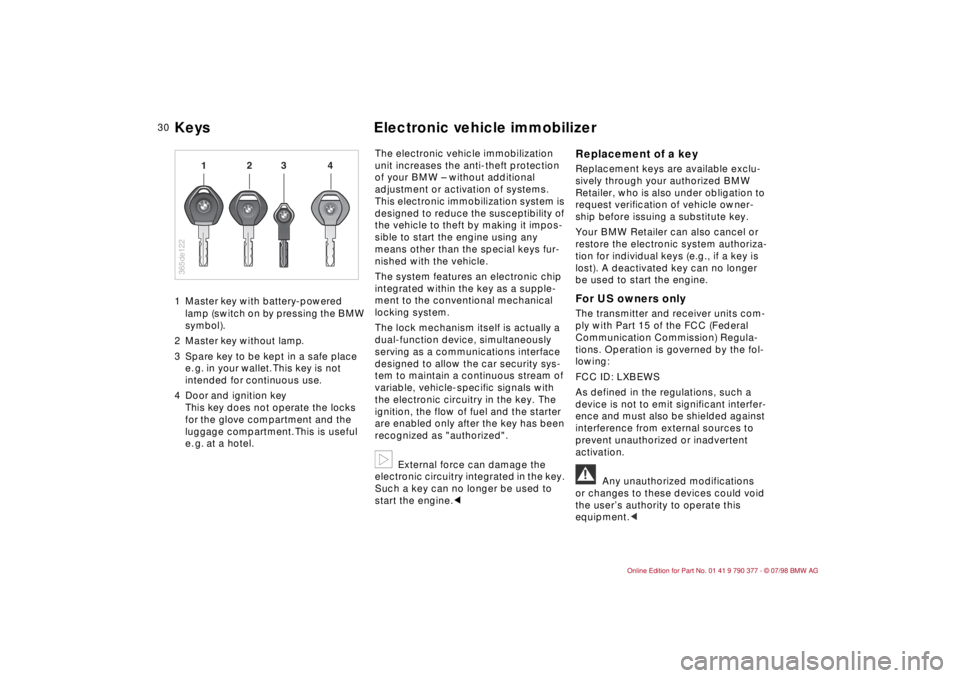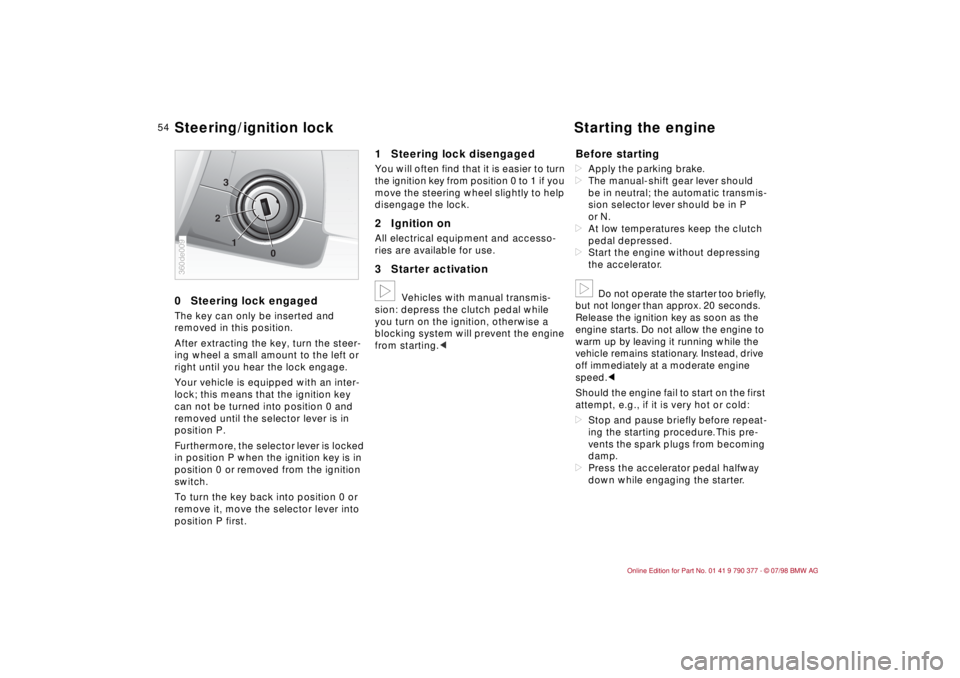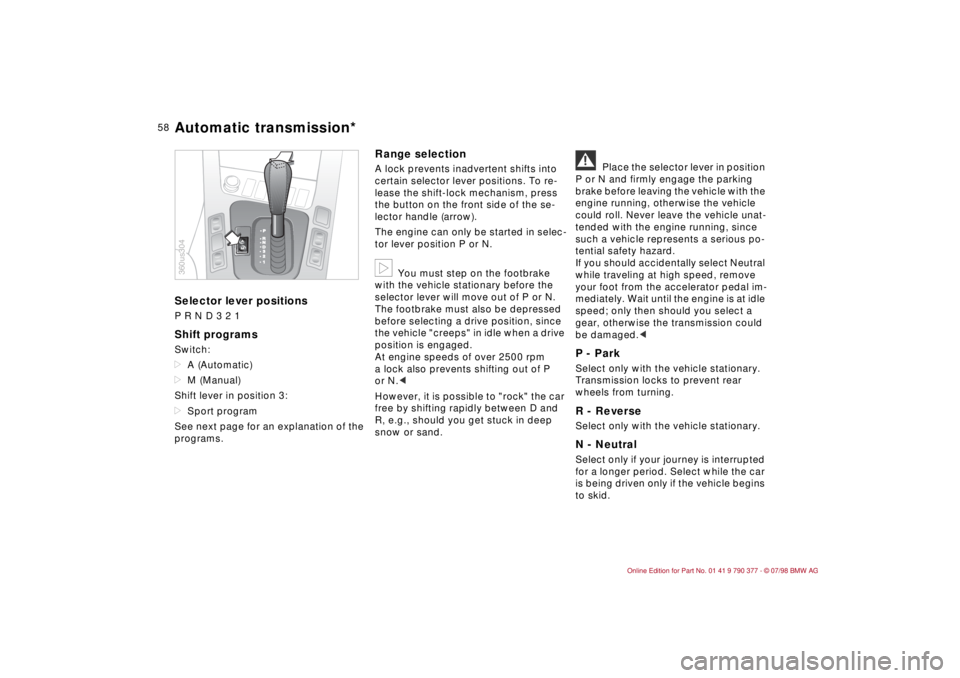1998 BMW CONVERTIBLE engine
[x] Cancel search: enginePage 29 of 179

28
Locks and security systems:
Keys30
Electronic vehicle immobilizer 30
Doors31
Luggage compartment lid33
Luggage compartment34
Power windows35
Sliding/tilt sunroof36
Convertible top operation37
Adjustments:
Seats43
Steering wheel45
Mirrors46
Passenger safety systems:
Safety belts47
Child restraint system48
Installing child seats49
Airbags50
Child-safety locks52
Rollover protection system Ð
convertible52Driving:
Steering/ignition lock54
Starting the engine54
Switching off the engine55
Parking brake56
Manual transmission57
Automatic transmission58
Turn signals/high beam60
Wiper/washer system61
Cruise control62
Everything under control:
Odometer63
Tachometer63
Energy control63
Fuel gauge64
Coolant temperature gauge64
Service Interval Display64
Multi-Information Display (MID)66
Outside temperature display
and digital clock68
Check Control71
Check Control with outside
temperature display and
digital clock74
Onboard computer77
Page 31 of 179

30
1 Master key with battery-powered
lamp (switch on by pressing the BMW
symbol).
2 Master key without lamp.
3 Spare key to be kept in a safe place
e. g. in your wallet. This key is not
intended for continuous use.
4 Door and ignition key
This key does not operate the locks
for the glove compartment and the
luggage compartment. This is useful
e. g. at a hotel.The electronic vehicle immobilization
unit increases the anti-theft protection
of your BMW Ð without additional
adjustment or activation of systems.
This electronic immobilization system is
designed to reduce the susceptibility of
the vehicle to theft by making it impos-
sible to start the engine using any
means other than the special keys fur-
nished with the vehicle.
The system features an electronic chip
integrated within the key as a supple-
ment to the conventional mechanical
locking system.
The lock mechanism itself is actually a
dual-function device, simultaneously
serving as a communications interface
designed to allow the car security sys-
tem to maintain a continuous stream of
variable, vehicle-specific signals with
the electronic circuitry in the key. The
ignition, the flow of fuel and the starter
are enabled only after the key has been
recognized as "authorized".
b
External force can damage the
electronic circuitry integrated in the key.
Such a key can no longer be used to
start the engine.c
Replacement of a keyReplacement keys are available exclu-
sively through your authorized BMW
Retailer, who is also under obligation to
request verification of vehicle owner-
ship before issuing a substitute key.
Your BMW Retailer can also cancel or
restore the electronic system authoriza-
tion for individual keys (e.g., if a key is
lost). A deactivated key can no longer
be used to start the engine.For US owners onlyThe transmitter and receiver units com-
ply with Part 15 of the FCC (Federal
Communication Commission) Regula-
tions. Operation is governed by the fol-
lowing:
FCC ID: LXBEWS
As defined in the regulations, such a
device is not to emit significant interfer-
ence and must also be shielded against
interference from external sources to
prevent unauthorized or inadvertent
activation.a
Any unauthorized modifications
or changes to these devices could void
the userÕs authority to operate this
equipment.c
14
BMW
BMW
BMW
BMW
23
365de122Keys Electronic vehicle immobilizer
Page 40 of 179

39
At a glanceControls Car careRepairsTechnicalDataIndex
Closing convertible topMove ignition key into position 1.
Unlock and open the convertible top
storage compartment. Lift out the top
by the side guide piece and the front
top frame.b
From ignition key position 1 or with
the door open: If the side windows are
closed, they move downward slightly
when the convertible top compartment
unlocking handle is operated. Move the
side windows into the desired position
or close them after closing the convert-
ible top.cPosition the rear top bow vertically.
Close the convertible top compartment
lid by pressing down on both sides until
they are heard to engage securely. Fold
down the top bow.
When the convertible top compartment
lid is closed, the central locking system
is automatically unlocked, i.e., the lug-
gage compartment is no longer locked
and can be opened again.
Pull the convertible top frame onto the
windshield frame with the locking han-
dle and lock the top by turning the han-
dle until it is heard to engage.
The rear convertible top bow is auto-
matically pressed onto the convertible
top compartment lid and closes water-
tight under tension.
b
If the convertible top or the rear
window begins to flutter at high speeds,
increase the air intake via the ventilation
control to prevent a vacuum from
resulting in the passenger compart-
ment.c
Fully automatic convertible top
operation
*
The fully automatic convertible top per-
fectly combines extremely simple, com-
fortable operation with reliable protec-
tion from the elements. Here are a few
tips to ensure that you have years of
pleasure with your convertible:
It is advisable to close the top when the
vehicle is parked. The closed top not
only protects the passenger compart-
ment from unforeseen weather-related
damage, it also provides a certain
degree of theft protection. Even with
the top closed, it is always advisable to
keep valuables locked in the luggage
compartment.
Do not mount roof racks on the convert-
ible top. Please contact your BMW
Retailer for suitable mounting equip-
ment and other accessories.
To prevent damage, do not operate the
top at temperatures below 325F (0
6
).
To protect the battery, it is advisable to
operate the top with the engine running
when possible.
36cde010Convertible top operation
Page 55 of 179

54
0Steering lock engagedThe key can only be inserted and
removed in this position.
After extracting the key, turn the steer-
ing wheel a small amount to the left or
right until you hear the lock engage.
Your vehicle is equipped with an inter-
lock; this means that the ignition key
can not be turned into position 0 and
removed until the selector lever is in
position P.
Furthermore, the selector lever is locked
in position P when the ignition key is in
position 0 or removed from the ignition
switch.
To turn the key back into position 0 or
remove it, move the selector lever into
position P first.
1 Steering lock disengagedYou will often find that it is easier to turn
the ignition key from position 0 to 1 if you
move the steering wheel slightly to help
disengage the lock.2 Ignition onAll electrical equipment and accesso-
ries are available for use.3 Starter activationb
Vehicles with manual transmis-
sion: depress the clutch pedal while
you turn on the ignition, otherwise a
blocking system will prevent the engine
from starting.c
Before startingdApply the parking brake.
dThe manual-shift gear lever should
be in neutral; the automatic transmis-
sion selector lever should be in P
or N.
dAt low temperatures keep the clutch
pedal depressed.
dStart the engine without depressing
the accelerator.b
Do not operate the starter too briefly,
but not longer than approx. 20 seconds.
Release the ignition key as soon as the
engine starts. Do not allow the engine to
warm up by leaving it running while the
vehicle remains stationary. Instead, drive
off immediately at a moderate engine
speed.c
Should the engine fail to start on the first
attempt, e.g., if it is very hot or cold:
dStop and pause briefly before repeat-
ing the starting procedure. This pre-
vents the spark plugs from becoming
damp.
dPress the accelerator pedal halfway
down while engaging the starter.
1 2
03
360de009Steering/ignition lock Starting the engine
Page 56 of 179

55
At a glanceControls Car careRepairsTechnicalDataIndex
When starting a cold engine at extreme-
ly low temperatures (+55F/-156 or be-
low) or at high altitudes (above 3,300 ft./
1,000 meters), proceed as follows:
dAt the first attempt, keep the starter
engaged for a bit longer (approx.
10 seconds).
dPress the accelerator pedal halfway
down while engaging the starter.
If you operate the vehicle for longer
periods of time at high altitudes and
very low temperatures, put into the
engine an oil with a viscosity of 5WÐ30
(refer to page 126). Please contact your
authorized BMW Retailer for additional
information.a
Never allow the engine to run with
the vehicle standing in an enclosed ar-
ea. The exhaust gases contain carbon
monoxide, an odorless and colorless,
but highly toxic gas. Breathing the ex-
haust gases poses an extreme health
risk, and can lead to unconsciousness
and death.
Never leave the vehicle unattended with
the engine running, as such a vehicle
represents a serious potential safety
hazard.cTurn the ignition key to position 1 or 0.
a
Always remove the ignition key
and engage the steering lock before
leaving the vehicle.
Vehicles with manual transmission:
Always engage the parking brake when
parking on slopes and inclined surfaces,
since selecting 1st gear or reverse may
not provide adequate resistance to roll-
ing.
Vehicles with automatic transmission:
Place the selector lever in Park.c
Starting the engine Switching off the engine
Page 59 of 179

58
Selector lever positionsP R N D 3 2 1Shift programsSwitch:
dA (Automatic)
dM (Manual)
Shift lever in position 3:
dSport program
See next page for an explanation of the
programs.
Range selectionA lock prevents inadvertent shifts into
certain selector lever positions. To re-
lease the shift-lock mechanism, press
the button on the front side of the se-
lector handle (arrow).
The engine can only be started in selec-
tor lever position P or N.b
You must step on the footbrake
with the vehicle stationary before the
selector lever will move out of P or N.
The footbrake must also be depressed
before selecting a drive position, since
the vehicle "creeps" in idle when a drive
position is engaged.
At engine speeds of over 2500 rpm
a lock also prevents shifting out of P
or N.c
However, it is possible to "rock" the car
free by shifting rapidly between D and
R, e.g., should you get stuck in deep
snow or sand.
a
Place the selector lever in position
P or N and firmly engage the parking
brake before leaving the vehicle with the
engine running, otherwise the vehicle
could roll. Never leave the vehicle unat-
tended with the engine running, since
such a vehicle represents a serious po-
tential safety hazard.
If you should accidentally select Neutral
while traveling at high speed, remove
your foot from the accelerator pedal im-
mediately. Wait until the engine is at idle
speed; only then should you select a
gear, otherwise the transmission could
be damaged.c
P - ParkSelect only with the vehicle stationary.
Transmission locks to prevent rear
wheels from turning.R - ReverseSelect only with the vehicle stationary.N - NeutralSelect only if your journey is interrupted
for a longer period. Select while the car
is being driven only if the vehicle begins
to skid.
360us304Automatic transmission*
Page 60 of 179

59
At a glanceControls Car careRepairsTechnicalDataIndex
D - Drive (automatic shift program)This position is designed for driving
under all normal operating conditions.
All forward gears are selected by the
transmission as necessary. 3 - Sport Program, direct controlThis position is designed for perfor-
mance-oriented driving, and features
delayed upshifts for optimal utilization
of the vehicle's power reserves.
When D is engaged, the transmission
may respond to certain conditions by
repeatedly shifting between 3rd and 4th
gears. You can select this position to
suppress upshifts into 4th gear and pre-
vent the transmission from "hunting" in
this way.
2 and 1 - Mountain ascents and
engine brakingSelect these positions to prevent un-
desired shifts on mountain roads or
extended uphill and downhill stretches.
These ranges let you use the engine's
braking effect to maximum advantage.
The transmission upshifts only as far as
the selected gear (1st or 2nd).
Do not move the selector lever to either
of these positions when traveling at
speeds of 108 mph (170 km/h) or
above. The transmission downshifts
only at correspondingly low speeds."Kickdown" (automatic downshift)To obtain maximum acceleration, the
accelerator pedal can be depressed
beyond the normal to the full-throttle
position, at which a pressure point must
be overcome.
Shift programsA - Automatic program
For economical driving. This is the initial
position each time the engine is started.
M - Manual program
This program is for driving conditions
under which the selected gear is to be
retained. The transmission then remains
in this gear both when starting off and
during acceleration. With this program
you drive only in 3rd gear in position D.
It is advantageous, e.g., on slopes or
when towing a trailer, to drive in selec-
tor lever position 1 or 2, or in winter on
slippery roads in selector lever position
3, which enables gentle starts and pre-
vents undesirable shifting.
Automatic transmission*
Page 61 of 179

60
Indicator lamp for shift
electronicsdIf the lamp fails to go out or
dif it lights up during driving, there is a
malfunction in the shifting electronics
or in the transmission.
Bring the vehicle to a stop, select trans-
mission position "P", set the parking
brake and turn the engine off (ignition
key to position 0).
Wait a few seconds, then start the
engine.
If the indicator lamp goes out after a
few seconds, normal transmission per-
formance has been restored. Drive off
normally.
If the indicator lamp does not go out, all
selector lever positions can still be
selected, however in the forward posi-
tions the vehicle has limited perfor-
mances as it drives only in the 3rd or
4th gear.
If this happens, avoid extreme engine
loads and consult the nearest autho-
rized BMW Retailer.
a
Never carry out any work in the
engine compartment without first
ensuring that the transmission is in Park
or Neutral. Never leave children in the
vehicle unattended.c
For information on tow-starting, towing
and jump starting refer to pages 153
and 154.
1 High beam (blue indicator lamp)
2 Headlamp ßasher
3 Turn signal indicator (green indicator
lamp and rhythmic ticking of the
blinker relay).
Flashing of the indicator lamp and tick-
ing faster than normal: a turn-indicator
lamp is defective.
To signal brieflyPress the lever up to but not beyond the
lock.
O
Goes out after the engine has
started.
1
2
3
3
360de039
Automatic transmission*Turn signals/high beam